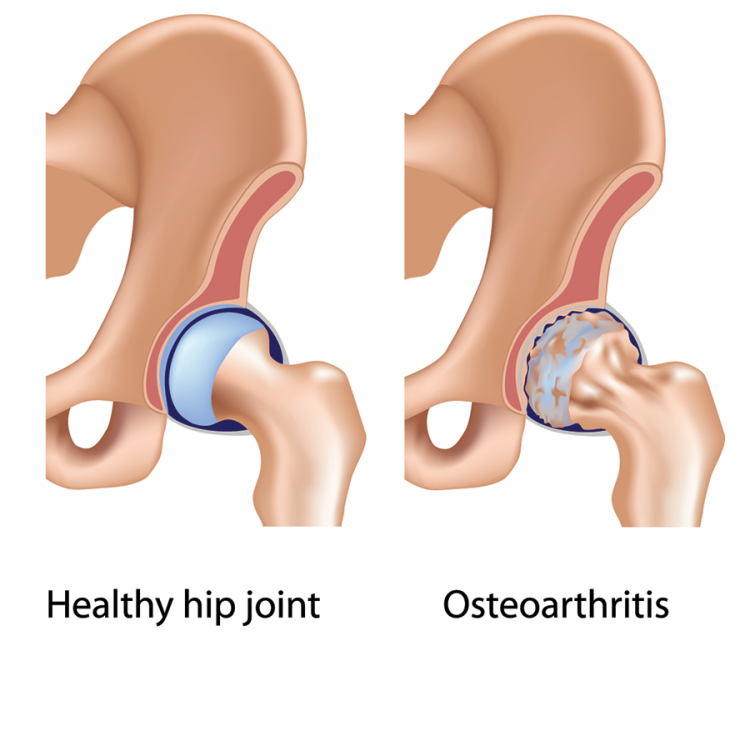Hip injuries
Hip pain, injuries, and arthritis are common. At The Stone Clinic, we often see athletes and patients who have tightness at their hips from tight iliotibial bands or hamstrings. They present with hip pain, usually on the outside of the hip as a result of this muscle and tissue tightness. Often, physical therapy, gait training, and muscle strengthening can help relieve the pain from these inflammations.
About the hip joint
The hip joint consists of the top of the femur and the acetabulum of the pelvis. Both joint surfaces are covered with articular cartilage. This “ball and socket joint” moves in multiple directions (flexion/extension, abduction/adduction, internal/external rotation), but it is also quite stable. The labrum increases the depth of the acetabulum, which in turn creates increased security of the femur. The primary function of the hip joint is to support the body during static and dynamic positions.

Hip injuries and disorders
Hip injuries are less common as the hip joint is protected by thick muscle tissues; however, hip arthritis is relatively common and can often be treated with physical therapy, range of motion exercises, anti-inflammatory medications, glucosamine, and viscosupplementation (lubrication injections placed directly into the hip joint itself). In general, the advice of “go home and rest your hip and wait for joint replacement” is not current. At The Stone Clinic, we believe that early intervention with physical therapy, range of motion exercises, strength training, bicycling, and swimming permit most patients with hip arthritis to progress back to activities and delay for years the time at which joint replacement may be required.
It is uncommon that the hip is injured through acute trauma and typically pain is from degenerative joint disease or an inflammatory process such as bursitis. Low back disorders can mimic hip disease, so the low back needs to be cleared before treating the hip. Hip disease can lead to low back issues due to the biomechanical relationship between the two areas.
Some common disorders at the hip are trochanteric bursitis, muscle strains, labral tears, and arthritis.
Trochanteric Bursitis occurs in the lateral (outside) region of the hip and can radiate down the lateral aspect of the thigh to the knee. A person with trochanteric bursitis will have pain with ascending stairs and lying on the involved side. The pain is typically deep and aching. Treatment would involve avoiding the irritating positions, use of ice, soft tissue mobilization, ultrasound, stretching, non-steroidal medications (Aleve and Advil), and strengthening. A cortisone injection is usually very helpful to eliminate the pain and inflammation
Muscle strains typically occur at the weakest link of the muscle-tendon unit. The musculotendinous junction may give way or the bony attachment may be damaged when increased stress is applied to an area. The most common hip muscles that are strained are the hamstrings and rectus femoris; however, it is not uncommon to have injury to the adductors or the iliacus. Treatment involves ice, ultrasound, and gentle stretching initially. As healing occurs, soft tissue mobilization and strengthening are added to the program.
Degenerative joint disease (Hip Arthritis) has various causes from injury to genetics. Symptoms present as pain in the hip area, and most often in the groin, that can radiate down the leg and into the low back. Ambulation, standing, and squatting can be painful. People with arthritis of the hip benefit from soft tissue mobilization, joint mobilization, stretching, strengthening, gait training, and wearing supportive shoes. Lubricating injections and cortisone can be helpful. If the symptoms become too severe and have limited the person’s ability to complete daily activities, surgery is the next option. We recommend yoga, Pilates, pool exercises, and other forms of stretching and strengthening for all hip arthritis patients.
In the younger population, there are two disorders that can occur at the hip. The first is Legg-Calve-Perthes disease in which the femoral head becomes flattened and results in decreased hip range of motion. There is no known cause but this disease typically occurs in young, active people. The child will complain of pain in the inner thigh and knee. The common treatment for this disorder is stretching, strengthening, and bracing. The second disorder occurs in overweight boys during a period of rapid growth. This condition is called “slipped capital femoral epiphysis,” in which the head of the femur becomes displaced from its normal position. The treatment is surgery with rehabilitation to follow.
Hip treatment
To help protect your hip, it is wise to be on a daily stretching program and a strengthening program seven days a week. Beneficial stretches would be for the hamstrings, quadriceps, and gluteus muscles. Strengthening exercises should focus on the gluteus muscles and hamstrings. Some suggestions are bridging, foot-on-ball bridging with alternating arm reaches, squats, side steps with a Theraband around the ankles, and single leg balance.